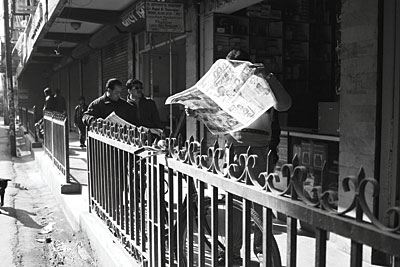 FOO CHEE CHANG PRINT RULES: Kantipur's lucky draw for inverters highlighted the woes of electronic media in Nepal |
Despite the existence of a dozen television channels and over 200 FM radio stations, the year 2066 BS too belonged to the print media. The Nepali daily Nagarik and its sister publication Republica burst onto the scene, throwing the biggest bash in town when the twins completed 100 days. The tabloid Naya Patrika maintained its innovative streak. The trusted warhorse Kantipur consolidated its hold upon the public mind. And the Grand Old Lady of New Road � the venerable Gorkhapatra � survived the vicissitudes of the marketplace by devoting a part of the paper exclusively to the marginalised national languages of Nepal.
With so many daily publications to choose from, weekly newspapers lost some ground. However, newsmagazines didn't do too badly. The weekly Nepal, from the Kantipur stable, maintained its regularity and visibility on the newsstands. Fortnightly Himal Khabarpatrika contributed to the constitutional debate through a comprehensive package in every issue. Other periodicals such as Madhuparka, Yuva Manch and Mulyankan kept their own niches intact. The print media may be under the hammer in the developed world, but here in Nepal it's live and kicking. Publishers may not be very happy with advertising revenue, but editors have little to complain about as their readership and influence in national affairs rise.
The success of the print media can partly be attributed to the kind of fluid politics that makes straight reporting a dull and repetitive task. What can television cameras do when decisions are taken behind closed doors? The print media, by contrast, can have a field day analysing conspiracy theories from every possible angle and speculating about outcomes.
With little to report on Maoist activities in the countryside or the diplomatic games being played out in Kathmandu, television cameras rushed around the capital chasing beauty queens, aging cine-actors and bevies of politicos on their way to or from New Delhi. Some junior ministers made desperate attempts to grab media attention by slapping a government officer, breaking the windshield of a car or manhandling a policeman on duty. But when nothing substantive was happening, the cameras alone could do nothing. Power cuts ensured audiences wouldn't sit in front of the idiot box anyway.
The news on the radio, too, lost some of its sheen with hourly updates repeating the same thing all through the year: political parties had failed to reach a consensus. There are so many stations doing the same thing, all at the same time, that no FM channel has a current affairs talk-show host who can hold the attention of listeners for long.
In this year's long silly season of feckless government and wearisome opposition, the print had a clear lead over television and radio in making up stories about the power struggle within UML and the Maoist politburo alongside reporting on the antics of Sujata Koirala in the Nepali Congress. The Nepali print media also began to learn the ropes of Murdochisation, as news was turned into infotainment. Newspapers experimented with provocative headlines, spicy photos, and a jaunty rightward tilt in the overall content.
Kantipur exercises almost full-spectrum dominance in the media with a direct presence in television, radio, the Internet and print. The mainstay of its media empire, however, continues to be the Kantipur daily. Perhaps there is a reason to celebrate this. As political thinker Alexis de Tocqueville noted, "Newspapers maintain civilization".



